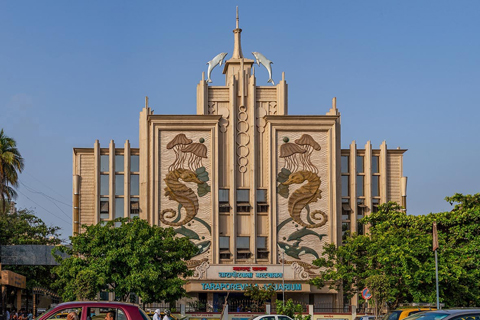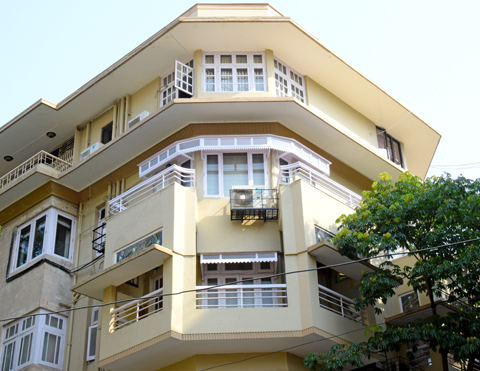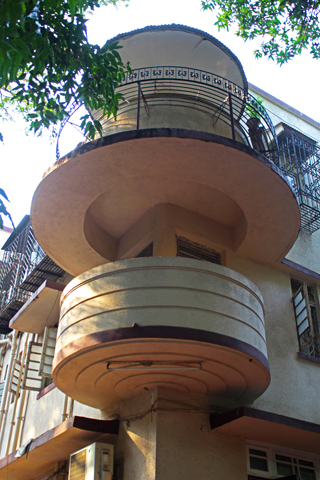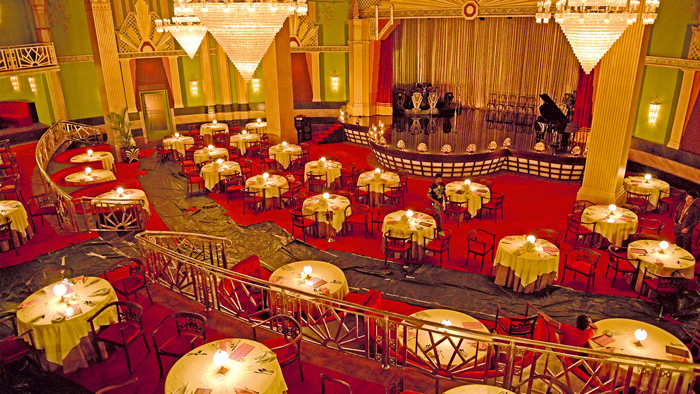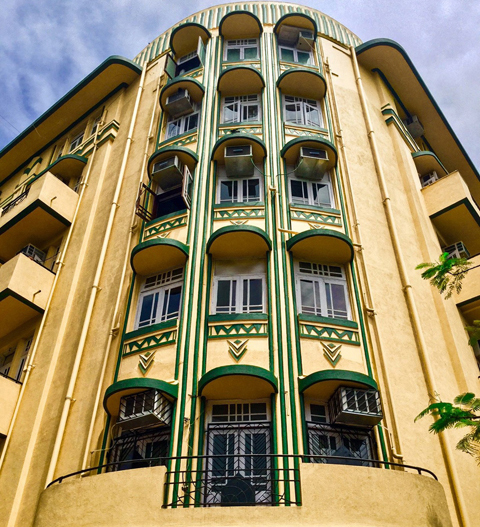BOMBAY DECO

MUMBAI’S NOD TO THE ART DECO MOVEMENT
Mumbai has the second largest concentration of Art Deco buildings in the world, after Miami. In the mid-1900s, these architectural gems transformed Bombay, as it was then called, putting it in an exclusive club of fashionable cities of the world. Today a cluster of these buildings is a UNESCO World Heritage Site.
At the southernmost tip of Mumbai, wedged between the Arabian Sea and the sprawling metropolis, stands The Oberoi, Mumbai. Besides its restaurants, it is also famous for its endless views of the ocean, and of the Marine Drive boulevard—an iconic vista in a space-starved city. Colloquially known as “The Queen’s Necklace,”—for how its streetlights appear from afar at night—Marine Drive is at the heart of Mumbai’s famed Art Deco district. Boasting dozens of these stylish structures—homes, offices, hotels, and cinemas—this famed boulevard, along with another cluster of such gems, surrounding the nearby Oval Maidan, is now recognized by UNESCO as a World Heritage Site.
The rich legacy of this trend that flourished in the 1930s and 1940s continues to endure in our times. Within the aforementioned Oberoi Hotel is the newly opened The Eau Bar, an elegant space with an outdoor deck. Taking its design cues from some of the oldest buildings along that stretch, its rounded corners and striking red velvet walls are reminiscent of the indulgent jazz bars of the Art Deco era.
Art Deco is a style of visual arts and architecture that influenced the urban cities across the world in the early 1920s. The style, born in Paris and introduced to the world at the International Exhibition of Modern Decorative and Industrial Arts in 1925, blended modern sensibilities of the times with diverse motifs influenced by emerging aesthetics from around the world. It was adopted by major cities such as New York, Miami, London, Amsterdam, and finally Mumbai.
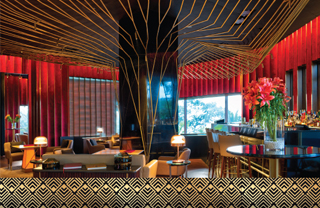 (Left) The rich legacy of Art Deco continues to endure: the new Eau Bar at Oberoi, Mumbai
(Left) The rich legacy of Art Deco continues to endure: the new Eau Bar at Oberoi, Mumbai
The erstwhile city acquired its Art Deco treasures thanks to the Indian royal families who had a presence in the city, as also to the well-travelled merchants and entrepreneurs expressing their love for contemporary ways of living they had experienced in Europe. Thanks to the Brits, Mumbai was already home to Victorian and Gothic buildings much before the explosion of Art Deco brought on by both Indian and British architects. The influx of Art Deco enhanced the skyline of the area with a rich mix of architectural gems that earned it the enviable UNESCO citation.
THE GLORY DAYS OF ART DECO IN MUMBAI
The Backbay Reclamation Scheme—an ambitious undertaking in 1920—to expand the limits of this landlocked city, was envisioned as an area that would offer a welcome relief from the congested spaces of the native city. A beautiful promenade and public squares being part of the plan, the upscale projectnaturally lent itself perfectly to the rising ambitions of those who were scouting for ideal locations for their newfound love of Art Deco.
The approximately 440 acres of reclaimed land stretching from the western edge of Oval Maidan and Churchgate to Sir Pherozeshah Mehta Road, MG Road, and Marine Drive thus evolved as Mumbai’s Art Deco Precinct—one that writer Salman Rushdie described, in one of his novels, as “a glittering Art Deco sweep … not even Rome could boast.”
According to Abha Narain Lambah, a Conservation architect, the Backbay Reclamation Scheme propelled Bombay from a 19th-century Victorian town to a modern, international city. It was the first Art Deco district in India, creating blocks of such buildings starting in 1929 and extending in waves of construction from the 1930s to 1940s. “Decades before the construction of Le Corbusier’s modern icons of Chandigarh, Bombay’s Art Deco had given India its first tryst with the new architecture of reinforced concrete,” says Lambah.
Few cities on the subcontinent could rival the dynamism unfolding in Bombay at that time. Author Gyan Prakash, who wrote about Mumbai’s evolution in his book, Mumbai Fables, says, “Art Deco was synonymous with a new fashionable lifestyle that proudly declared ‘The future is here.’”
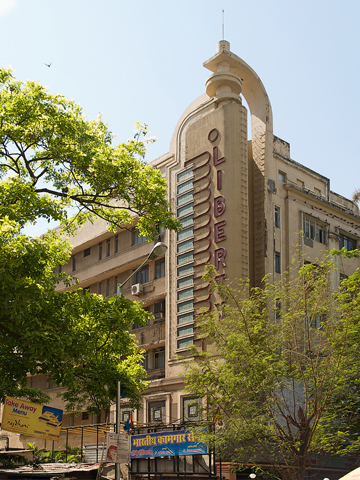

“Some of the best buildings constructed in the Art Deco aesthetic style faced the Arabian Sea in a spectacular crescent and spelt the advent of modernity in India,” says Lambah who worked on the UNESCO dossier with several residential bodies as well as the Art Deco Mumbai Trust (AMDT) to secure the recognition as a World Heritage Site. The buildings were partly inspired by local design elements, earning the moniker ‘Bombay Deco’ for the city’s Art Deco.
Left and Down: The iconic Liberty Cinema from the heydays of Bombay Deco. (Photo: Courtesy, Art Deco Mumbai Trust)
“Tropical imagery, ziggurats, nautical designs, and geometrical patterns are some of the distinctive features unique to Bombay Deco,” says Atul Kumar, founder of the AMDT, a not-for-profit conservation, documentation, and advocacy body.
(Down Image) The Taraporevala Aquarium, flaunting its unique design and architecture.
|
|
|
|
Silver Foil, the residential building in central Mumbai has projecting balconies and continuous chajjas (overhangs) made from reinforced concrete, a construction material which was new in the 1930s and allowed several architectural interventions, thought impossible earlier. (Photo: Art Deco Mumbai Trust) |
Sanghrajka House, located in Matunga, a western suburb of Mumbai, was built by Architect Taraporewalla & Co. The building is marked by the white vertical band created by chajjas, recessed balconies and clean grill work. (Photo: Art Deco Mumbai Trust) |
Vishaka Bhat, a researcher and documenter with AMDT, who often takes people on the Oval Maidan Art Deco walk, says that the architects of Mumbai brought two important changes to the style: inclusion of tropical imagery like palm fronds and elephants, and climate-responsive elements, such as windows designed to promote cross circulation.
For Mumbai, this represented not merely an architecture style. “It, instead, mobilized the aspirations of Bombay post-Independence,” contends architect Ashish Shah, who grew up in one of the Art Deco buildings along Marine Drive and has designed modern homes amidst some of the old treasures that continue to survive. “Though minimal in style and far less ornate than what the best of Indian architecture traditionally represented, it also marked a movement away from the austerity of Mahatma Gandhi. Art Deco was a radical alternative. Several industrialists and home-grown architects, who worked with the British architects, adapted it as a sign of Bombay’s future as a great global port city.”
HARBINGER OF SOCIAL REVOLUTION
The Art Deco movement also brought in a social and cultural revolution of sorts. Interestingly, what began as an ‘elitist’ trend in the affluent neighborhoods of Mumbai spread its way through suburbs such as Dadar, Matunga and Sion. Many of the Gujarati and Jain traders living in these suburbs, in a bid to be seen as ‘fashionable’ south Mumbai residents, built buildings in this style for their joint families.
With gaining popularity amongst varied strata of Bombay’s upwardly mobile, the infusion of traditional Indian influences into this trend was bound to happen. This fusion of the ancient and the modern was yet another unique aspect of Bombay Deco. “The Art Deco elements included statues of Goddesses and a lot of Hindu religious symbolism, weaved into the fabric of what was then a modern style,” says Kumar.
The somewhat egalitarian spread of Art Deco had interesting consequences on the social fabric of the city. By that era of the mid-1900s, many Indian families were moving away from a joint system to live as nuclear families in urban areas, says Michael Windover, associate professor in the School for Studies in Art and Culture at Carleton University, Ottawa, Canada. “The rich invested in these Art Deco buildings, and then rented them out to the new migrants to the city,” says Windover, who has studied Mumbai’s Art Deco heritage. “These buildings allowed people to leave the rigid caste structures behind in their little towns and live cheek-by-jowl with people from other castes and communities. It helped define Mumbai’s cosmopolitan subculture.”
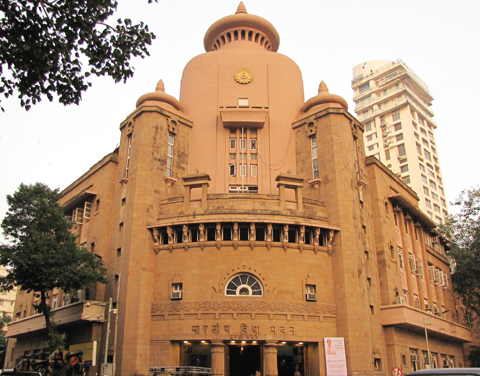 (Left) The Bharatiya Vidya Bhavan, a culture and arts institutions boasts a geometric brick façade made of concrete and Indo-Saracenic
(once known as ‘Hindoo’ style or even Indo-Gothic) domes made of cement, a blend of two different architectural styles. (Photo: Art Deco Mumbai Trust)
(Left) The Bharatiya Vidya Bhavan, a culture and arts institutions boasts a geometric brick façade made of concrete and Indo-Saracenic
(once known as ‘Hindoo’ style or even Indo-Gothic) domes made of cement, a blend of two different architectural styles. (Photo: Art Deco Mumbai Trust)
The UNESCO citation said it the best, when they stated, “The Victorian and Art Deco Ensemble of Mumbai forms an architectural development of Outstanding Universal Value embodying urban re-engineering in the context of colonial cities over the 19th and 20th centuries. The demolition of fortifications to restructure the Esplanade followed by the ambitious Backbay Reclamation Scheme was emblematic in Asia and the world, of a development stage in human history, the shift from fortified colonial towns to commercial cities in a modernising world. Collectively, this ensemble of Victorian and Art Deco buildings is unparalleled in its reflection of international modernity of the 19th and 20th centuries and influences the narrative of modernism in Asia.”
INSPIRING POP CULTURE
Over the years, a number of filmmakers, artists, product designers and even jewelry designers have recognized the city’s rich Art Deco heritage in various ways. For instance, jewelry brand Caratlane paid homage with its Bombay Deco collection two years ago. “We chose buildings such as Eros Cinema, Liberty Cinema, Empress Court, Regal Cinema, and Metro Cinema that are recognizable for their distinct Art Deco elements,” says designer Chetan Sharma. “This was a collection withclean lines, much like the buildings we referenced. We were also influenced by Anurag Kashyap’s movie, Bombay Velvet.”
Kashyap recreated the Art Deco era painstakingly for his 2015 ode to Mumbai’s evolution as a glamorous port city, complete with the machinations and scheming of the leading lights of that era. He modeled his buildings and homes, nightclubs and streets in the exact image of what Mumbai, or Bombay, was in that time. “Back then, there was optimism in the air, which can be seen in the public culture, in cinemas, jazz bars and the Art Deco buildings,” Kashyap says.
PRESERVING A PRICELESS HERITAGE
“We are one of the few cities where the Art Deco heritage is a ‘living heritage’, which means there are residents who still live in these buildings and use them,” says Kumar of AMDT.
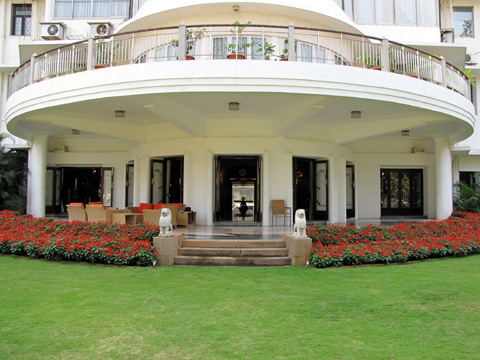 (Right) A semi-circular verandah with a cantilevered canopy projecting from the center of the building, into the drawing-room was the unique feature of Mafatlal House, built in 1937. (Photo: Art Deco Mumbai Trust)
(Right) A semi-circular verandah with a cantilevered canopy projecting from the center of the building, into the drawing-room was the unique feature of Mafatlal House, built in 1937. (Photo: Art Deco Mumbai Trust)
Among the residents is Dhun Lentin, whose family has lived in the beautiful Soona Mahal since 1939. Her three-bedroom house has a curved balcony facing the south-western seafront and windows running down the front. “We were among the earliest residents,” she says. “Malabar Hill and areas aroundit were occupied by high-ranking British officials and wealthy Indian families. But more modern families like mine, who had come into wealth by then, preferred the flamboyance of the Art Deco buildings.”
After partition, Punjabis and Sindhis from the other side of the border became the new tenants of these buildings.
Some unique factors posed a setback to these stylized buildings. In 1947, Mumbai passed the rigid Rent Control Act, which froze the rents to the amount prevalent at that time. Unfortunately for property owners, rents remained the same for more than 50 years, with small increases permitted since 1999. These artificially subdued rents—a slap in the face of actual market rents—turned off many owners from their otherwise prized possessions. “While some owners continue to look after the Art Deco propertiesbecause of the pride involved in it, some have fallen by the wayside,” Kumar says. “In the suburbs, where there are no heritage laws controlling their redevelopment, many Art Deco buildings have been replaced by modern edifices.”
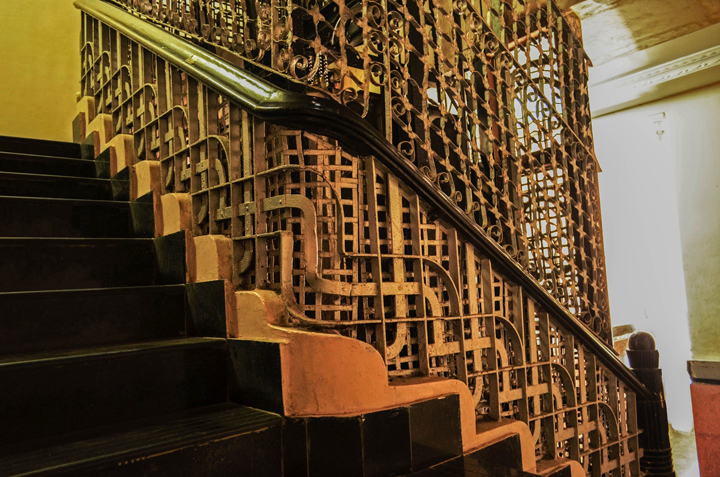 (Left) An ornate staircase in the Deco style inside Lalchand Mahal, on the UNESCO listed Art Deco stretch in Colaba. It abuts an intricately detailed metal elevator. (Photo: Deepali Nandwani).
(Left) An ornate staircase in the Deco style inside Lalchand Mahal, on the UNESCO listed Art Deco stretch in Colaba. It abuts an intricately detailed metal elevator. (Photo: Deepali Nandwani).
This is where a body like ADMT has played a substantial role. Kumar says that his workwith various citizens associations and NGOs revealed to him the need for residents to be involved in the conservation process. “We can pass all sorts of legislation, but if there is no contribution from the people who are living there, conservation won’t work,” he says. “That is how the idea of the association was born. It is an outreach program which combines social media, workshops, lectures at architecture academies, documentation, research and an online inventory.”
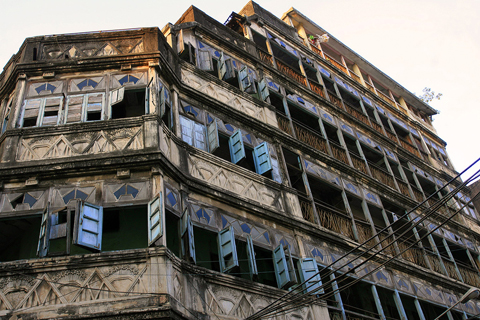
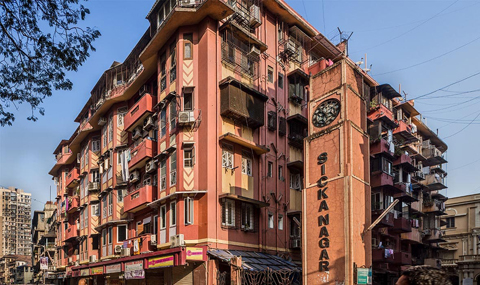 Two neglected Art Deco buildings in Andheri. Lack of Heritage laws combined with the rigid Rent Control Act passed in 1947 in Mumbai took a toll of some these buildings that were rented out. (Photo courtesy: Deven Verma).
Two neglected Art Deco buildings in Andheri. Lack of Heritage laws combined with the rigid Rent Control Act passed in 1947 in Mumbai took a toll of some these buildings that were rented out. (Photo courtesy: Deven Verma).
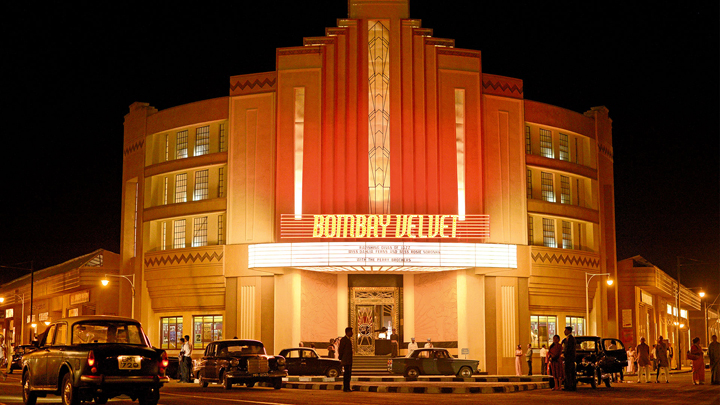
While the core team comprises trained architects, and handles most of the research and documentation, interns carry out fieldwork on a project basis. AMDT also offers restoration consultancy on a pro-bono basis to residents who approach them. The self-funded body works with schoolchildren to educate them about the need to conserve and preserve this heritage.
|
|
|
|
Filmmaker Anurag Kashyap’s Bombay Velvet painstakingly recreated the Art Deco vibe of the city |
The Shiv Shanti Bhavan, opposite Oval Maidan, was built in 1934 and featured trios of windows lined with curved shades, called ‘eyebrows’. (Photo: Deepali Nandwani) |
Younger generation like mine needs to continue to live here and make it its own. There is no reason why the interiors cannot be made modern or why you can’t adapt it to modern lifestyles without changing or harming the façade,” says Shah. Indeed, the real conservation lies in adapting these buildings to modern times.

The Art Deco movement shaped not just apartment blocks but also single- screen cinemas in Mumbai, which came up in the 1930s and 40s. Regal was the first to get off the ground and change the city’s popular culture.
Built in 1933 by architect Charles Steven—son of F. W. Stevens, designer of some of Bombay’s most significant Victorian public buildings—it housed a fully air-conditioned theater even back in the heyday. Its neon-colored facade, bold green interiors, and an underground parking garage attracted the affluent residents of the neighborhood to spend evenings at the cinemas. Regal, like most other of its Art Deco compatriots, screened only Hollywood movies back in the 1940s. It was also home to ice skating rinks and restaurants.
While Regal is on the verge of closure due to competition from snazzy multiplexes, many older theaters such as Metro and The Liberty Theatre have reinvented themselves for modern times. Nazir Hoosein, Liberty’s curator, historian and preservationist, inherited the cinema from his father Habib, a cotton trader with a passion for cinema. His father ran 45 cinemas of which The Liberty, designed by Canadian architect M. A. Riddley Abbott and Indian architect J. B. Fernandes, was said to be the most glamorous when it opened in 1949. The theater, which hosted premieres of movies such as Mehboob Khan’s Andaz, has been preserved in a pristine condition and now hosts theatre performances, film festivals and other events.
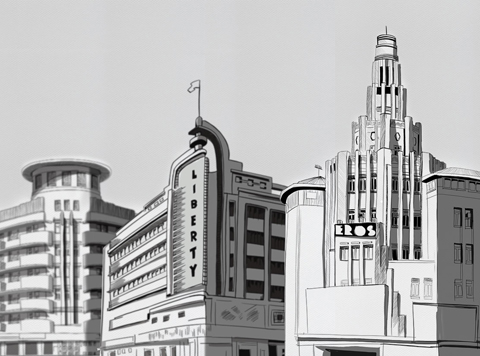 (Left) A sketch depicting two of the most iconic cinema houses of Mumbai: Liberty Cinema and Eros Cinema. (Photo: Art Deco Mumbai Trust)
(Left) A sketch depicting two of the most iconic cinema houses of Mumbai: Liberty Cinema and Eros Cinema. (Photo: Art Deco Mumbai Trust)
Another theater that has survived, though not in the same pristine condition as The Liberty or Metro, is Eros Cinema. Its V-shaped structure, partially clad with red Agra sandstone that contrasts with the light cream painted facade, is being restored. The ziggurat-like tower is a familiar site for most Mumbaikars who traverse the rush-hour crush at Churchgate Railway station. It serves as a visual marker in the Churchgate area within the Backbay Reclamation Scheme.
“I have travelled to many countries, but their Art Deco cinemas are nothing compared to ours,” says Hoosein, who believes that these single-screen theatres should be preserved and showcased as tourist spots by the government.
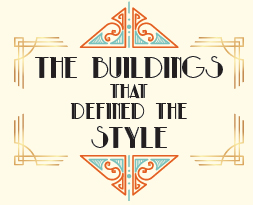
Besides building extensive sets, Anurag Kashyap captured in his movie Bombay Velvet, the beauty of Deco jewels such as Dhanraj Mahal and Rajjab Mahal. Built in the 1930s, Dhanraj Mahal was the former palace of the Raja Dhanrajgir of Hyderabad, a family of successful traders and bankers to the Nizams. Much like other traders who travelled extensively to Europe, the Dhanrajgir family was influenced by what they saw in the world’s trendiest cities, and recreated buildings that reflected global trends of the times.
Dhanraj Mahal, now a Grade III heritage structure, was designed by the famous architect firm of Gregson, Batler & King and constructed by Shahpoorji Chandabhoy, says Humayun Dhanrajgir, the former Glaxo chairman and scion of the Dhanrajgir family. Built in the early 20th-century Parisian design in a distinctive pink stone, it houses a vast central courtyard surrounded by residences. Some continue to be used as originally intended, while others have been converted into offices.
Empress Court, a magnificent structure that reflects the symmetry of nautical elements and geometrical patterns, is among the iconic Art Deco buildings of Mumbai. Kumar points out that Mumbai’s status as a coastal city finds an apt reflection in the nautical elements across several of these buildings in areas abutting the sea.
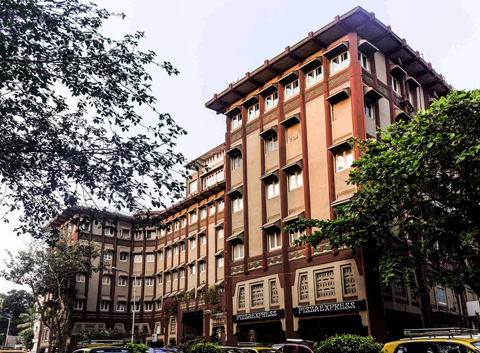 (Left) Dhanraj Mahal, the former palace of the Raja Dhanrajgir of Hyderabad, a family of traders and bankers to the Nizams of Hyderabad is now a Grade III heritage structure. Designed by Gregson, Batler and King, it displays early 20th-century Parisian design style in a distinctive pink stone. (Photo: Art Deco Mumbai Trust)
(Left) Dhanraj Mahal, the former palace of the Raja Dhanrajgir of Hyderabad, a family of traders and bankers to the Nizams of Hyderabad is now a Grade III heritage structure. Designed by Gregson, Batler and King, it displays early 20th-century Parisian design style in a distinctive pink stone. (Photo: Art Deco Mumbai Trust)
Residential buildings were also constructed on the plots that ran along the Queen’s Road (now Maharshi Karve Road) facing the Oval Maidan, creating a unified urban fabric. “Most of these buildings, such as Shiv Shanti Bhuvan and Rajjab Mahal, have highly decorative surfaces that evoke a sense of flamboyance in the way they use color, banding details, relief patterns, and motifs says Kumar.
Several of the Marine Drive’s buildings were financed, designed and built by Indians such as GB Mhatre. Credited with some of the most stylish Art Deco architecture in the city, Mhatre designed Soona Mahal, among other buildings, according to ADMT.
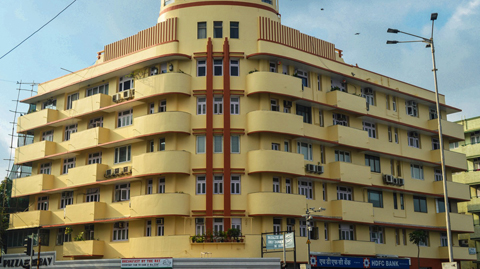 (Right) Soona Mahal, built in 1937, has a turret or viewing gallery that affords the finest view of Marine Drive’s sweeping bay. (Photo: Art Deco Mumbai Trust)
(Right) Soona Mahal, built in 1937, has a turret or viewing gallery that affords the finest view of Marine Drive’s sweeping bay. (Photo: Art Deco Mumbai Trust)
A wealthy Gujarati cinema tycoon named a trio of identical buildings, Kewal Mahal, Kapur Mahal, and Zaver Mahal on Marine Drive, after himself and two of his children. The Kuwaiti royal family owned Al Sabah Court which was the home of a young prince during the 1950s. One of the Marine Drive buildings was also home to yesteryear star Suraiya, as well as Nargis in later years.
Along the Marine Drive stretch are also Art Deco hotels such as Sea Green South Hotel, commissioned by the army and the security services during World War II. Most of these buildings were built by Bombay architects, initially in association with the British, and then as independent firms. The native architects were particularly innovative as they adapted Indian motifs onto their Deco-style plans. Indian firms spearheaded by architects such as G B Mhatre, Master Sathe & Bhuta, Bhedwar & Bhedwar, and Merwanji Bana & Co. were the pioneers and executors of Bombay Deco tradition.
Deepali Nandwani is a Mumbai-based freelance journalist, a columnist on luxury with CNBC-TV18, and an aficionado of everything heritage.
Enjoyed reading Khabar magazine? Subscribe to Khabar and get a full digital copy of this Indian-American community magazine.
blog comments powered by Disqus




